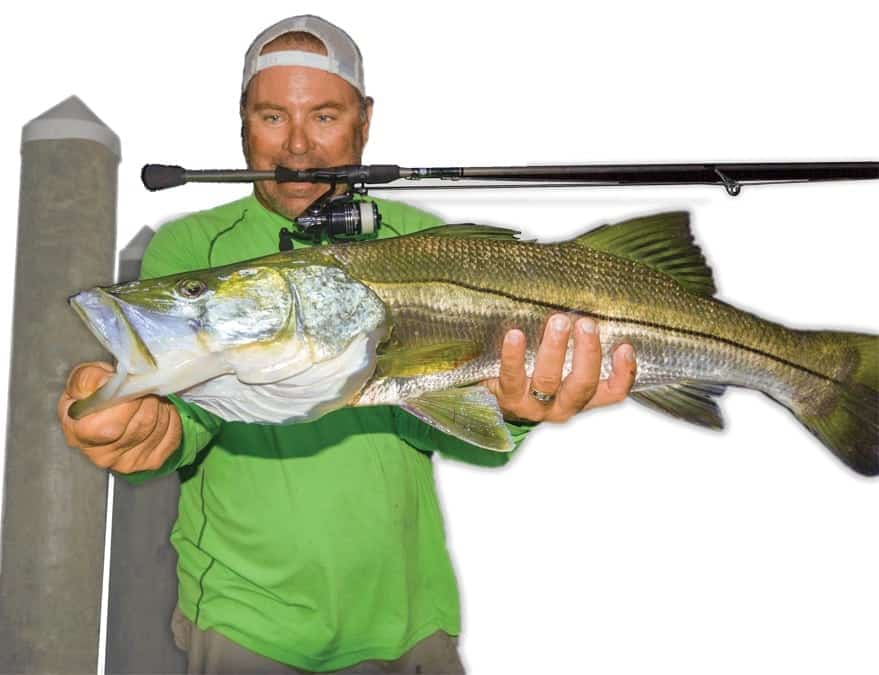[vc_row][vc_column][vc_column_text]
Late-night forays into dark waters provide an increased opportunity to catch “the big one.”
It was pitch-black and so quiet you could hear a plug drop, which is exactly what I was listening for as I sent a 5-inch Yo-Zuri Crystal Minnow hurtling into the darkness. Instead of the light splash I was expecting, I heard the lure clang as it landed on a small dock. With a gentle twitch of the rod tip, I tumbled it over the edge and began a slow retrieve. Three cranks of the reel handle later a furious striper weighing more than 30 pounds exploded on the swimmer.
Sometimes, things that go bump in the night are really big fish. That’s a lesson that comes with night fishing.[/vc_column_text][vc_column_text]There’s something about late- night fishing I find irresistible. Certainly, there is an intriguing eeriness about midnight forays, and the quiet, calm time for reflection is inviting.
So, too, is the opportunity to have a favorite flat, rip or hardened shoreline all to myself. Oh, but who am I kidding? The big ones come out to play after dark and, in the end, the increased chance to encounter a true trophy is what really puts me on the prowl. In any case, the mystique of not being able to clearly see your target, or the take, serves to make things even more tempting.
“That’s when trophy fish are most vulnerable,” says Captain Ryan Kane (Southern Instinct Fishing Charters, 239-896-2341, southerninstinct.com), a Fort Myers, Florida, charter skipper who makes no bones about why he likes to night fish into the dark hours,[/vc_column_text][vc_column_text]“There’s a lot of fishing pressure on the waters around here so the biggest snook, redfish and other game fish species hang back and wait for the sun to go down before moving up onto the flats. Fishing on the graveyard shift allows me to target those bigger fish with minimal competition.”
Indeed, for many inshore game fish species, the summer months are a stressful period. From snook, redfish, sea trout, and shark in southern waters to striped bass, bluefish, drum, and weakfish in mid-Atlantic and Northeast areas, water temperatures approach the upper limits of the comfort zone.
In addition, vacation-crazed tourists patrol the shores, and boaters, parasailers and Jet Ski jockeys crisscross channels and flats. To the fish, it must be maddening mayhem.
For the subaqueous inhabitants of such high-traffic areas, respite comes on rainy days or after the sun sets beneath the horizon. It’s then, when water temperatures decline and human interference retreats, that lunkers go on a feeding binge.
To be sure, nighttime fishing isn’t that much different from the daytime brand, but there are a few points to keep in mind if you want to make it worth the effort. First is pinpointing the most productive time to fish. Many late-night novices head out at 6 or 7PM and just keep on casting as the sun goes down. What they fail to realize, however, is that the nighttime bite is a factor of time. Following a hot, muggy day, the water must have a couple of hours to cool off, big fish need a while to unnerve, and baitfish require the cover of full darkness to move about more recklessly. Waiting until 10 PM or later before embarking on night fishing resolves most of these issues.
As important as fishing in the right time slot is keying on appropriate tides. Just like during the day, late-eating predators favor specific tides. Sea trout and weakfish, for example, are notorious for firing up on the slower stages of water movement. For both, the last quarter of incoming and first quarter of outgoing water usually produce best.
Bass and Blues, in contrast, will sometimes move up onto shallow flats with the first advance of incoming water, and their shallow-water feeding activity often peaks as the current picks up strength. Snook and redfish show a preference for dropping tides that drain shrimp, crabs and baitfish from expansive flats toward deeper water. As the tide starts to recede, they’ll often encroach on sandbars to meet their prey, retreating back to deeper water an hour or two before the tide bottoms out.
Like Kane, Captain Rich Jensen—a full-time charter skipper since 1970 running the Nancy Ann IV out of Orient, New York (631-477-2337, nancyanncharters.com)—has long been hooked on night fishing. He has a reputation for catching big bass year after year. His largest cow so far tipped the scales at 67 pounds, and he’s caught dozens topping 50 pounds on the late shift.[/vc_column_text][vc_column_text]Jensen and his fares hook a lot of their bass on live eels and dark-colored bucktails while drifting through serious rips far off the beach. Still, given the choice, he’d rather troll a big plug in shallower water closer to home if he’s looking for one large bruiser.
“Since the fish aren’t seeing your lures as much as sensing them,” he says, “you can get away with more after dark.
That’s not to say big fish don’t bite during daylight hours, just that for as good as it is during the daylight, it can be better in the darkness as trophy-caliber fish slide into the shallows and drop their guard.” Jensen notes that big bass move around a lot at night while feeding more freely, which increases the odds of hooking up. He favors full moon and new moon tides when intent on scoring with linesiders of double-take proportions.
While nighttime baitfishing varies little from the daytime routine, you’ll need to make a few adjustments to score consistently if using artificials. The most frequent mistake anglers make is retrieving lures too quickly. It’s vital to slow things down to a crawl, and then let up even more. I like to work quiet, subsurface plugs with a wide, wiggling action or large straight-tailed soft plastics.
Kane, by comparison, prefers to make a lot of noise with big Zara Spook surface lures. “If I’m missing sleep, I’m chasing lunkers,” he laughs. “I like a lure that makes a lot of noise and commotion.
With sight limited after dark, fish depend on other senses like vibration and scent to hone in on their meals. If they won’t hit the poppers and plugs, try cut mullet or bunker bait. Cast them up on a flat and let them just sit on the bottom. That oily scent draws predator species from quite a distance.”
As for where to go night fishing on the late shift, start with areas that produce during the day while adjusting for the likelihood that predator species will slide into shallower water nearby. Also, the cutting edge where nighttime and man-made lighting intersect draws its share of game fish. Don’t pass on the chance to work shadow lines along bridges and docks. Approach with stealth and drift into casting range if possible to avoid spooking your quarry.
Of course, there are some commonsense rules to heed should you head out after dark. Most important is to not venture into unfamiliar waters as rocks, navigational aids, sandbars and other late-night boaters are real hazards. Be sure to check out any area you might fish under daylight conditions before making a night run.
“Late-night adventures are not the time to experiment,” cautions Kane. “Fish areas you already know using techniques you’ve already mastered in broad daylight. No fish is worth risking your safety.”
It’s also a good idea before leaving the dock to make sure you are well-organized and to tell someone when you expect to return. Last, be sure to bring along plenty of bug spray if you plan to work back-bay waters. Monster snook, redfish and stripers aren’t the only things that feed after dark.
Tom Schlichter Southern Boating June 2016
Schlichter is a columnist for Newsday.[/vc_column_text][/vc_column][/vc_row]
















